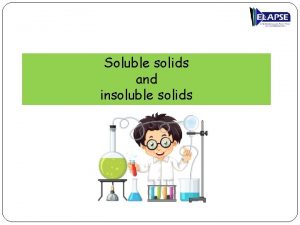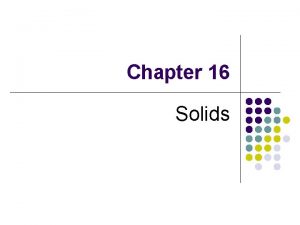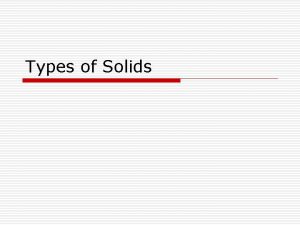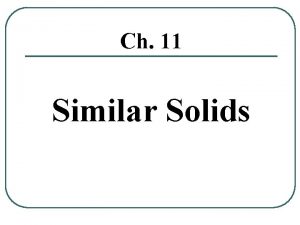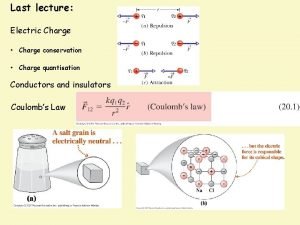Electric Charge And Electric Forces All things solids















- Slides: 15

Electric Charge And Electric Forces

• All things, (solids, liquids, and gases) are made of tiny particles called atoms. Electrons • Atoms are made of even smaller particles called protons, neutrons, and electrons. Protons Neutrons

• There are two types of electric charge—positive and negative. • Protons have a positive charge, and electrons have a negative charge. The amount of negative charge on an electron is exactly equal to the amount of positive charge on a proton. • Because atoms have equal numbers of protons and electrons, the amount of positive charge on all the protons in the nucleus of an atom is balanced by the negative charge on all the electrons moving around the nucleus. • Therefore, atoms are electrically neutral.

• An atom becomes negatively charged when it gains extra electrons. • If an atom loses electrons it becomes positively charged. • A positively or negatively charged atom is called an ion. It is important to understand that any object can become electrically charged.

Some materials hold electrons more loosely than others. As a result, electrons often move from one object to another. When this happens. The positive charge and negative charge on the objects are unbalanced. An unbalanced negative or positive electric charge on an object is sometimes referred to as a static charge. https: //www. youtube. com/watch? v=yc 2 -363 MIQs

Electric Fields • Charged objects don’t have to be touching to exert an electric force on each other. • Electric charges exert a force on each other at a distance through an electric field that exists around every electric charge. The electric force applied by an object’s electric field will either attract or repel other charged objects.

Electrons are more easily moved in some materials than in others. A material in which electrons cannot easily move is an electric insulator. Glass, rubber, wood, and even air are good electric insulators. A material in which electrons can easily move is an electric conductor. Most metal, such as copper and aluminum, are good electric conductors.

Electrons transfer between objects by contact, induction, or conduction. 1. Transferring Charge by Contact: When objects made of different materials touch, electrons tend to collect on the object that holds electrons more tightly.

2. Transferring Charge by Induction: A process by which one object causes two other objects that are conductors to become charged without touching them.

3. Transferring Charge by Conduction: When conducting objects with unequal charges touch, electrons flow from the object with a greater concentration of negative charge to the object with a lower concentration of negative charge. The flow of electrons continues until the concentration on charge of both objects is equal.

When you brush your hair, electrons transfer from the brush to your hair. What happens to these excess electrons in your hair? They transfer to things that come into contact with your hair or they transfer into the air. Gradually, your hair loses its charge. The process of an unbalanced electric charge becoming balanced is an electric discharge. It can occur slowly, or as quickly as a flash. It can be mild or extremely powerful.

Lightning is an example of a powerful electric discharge that occurs in an instant.

A lightning strike can severely damage a building or injure people. Lighting rods help protect people against these dangers. A thick wire connects the lightning rod to the ground. Providing a path for electric charges to flow safely into the ground is called grounding.

Lightning is both dangerous and unpredictable. Seek shelter in an enclosed building or a car with a metal top. Never stand under a tree. Stay away from water. And…

If you feel any tingling or the hairs on the back of your neck raise…. . . ”Assume the position” https: //www. youtube. com/watch? v=i. Cq. X 9 d 0 Yv_0
 Difference between charge and electric charge
Difference between charge and electric charge Difference between static and current electricity
Difference between static and current electricity Chapter 21 electric charge and electric field
Chapter 21 electric charge and electric field Chapter 21 electric charge and electric field
Chapter 21 electric charge and electric field Electric field k constant
Electric field k constant Dc o/d per item charge
Dc o/d per item charge Electric charges and electric forces lesson outline
Electric charges and electric forces lesson outline 7 things all living things do
7 things all living things do Like forces and unlike forces
Like forces and unlike forces What are some contact forces and some noncontact forces
What are some contact forces and some noncontact forces Net force
Net force Volcanoes constructive and destructive forces
Volcanoes constructive and destructive forces Name all the rays
Name all the rays Chapter 17 section 1 electric charge and force answer key
Chapter 17 section 1 electric charge and force answer key Charge symbol and unit
Charge symbol and unit Electric forces and fields concept review
Electric forces and fields concept review






















